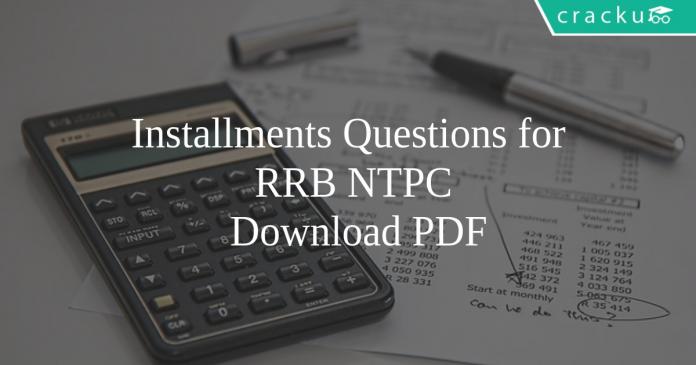Installments Questions for RRB NTPC PDF
Download RRB NTPC Installments Questions and Answers PDF. Top 15 RRB NTPC Installments questions based on asked questions in previous exam papers very important for the Railway NTPC exam.
Download Installments Questions for RRB NTPC PDF
Take a free mock test for RRB NTPC
Download RRB NTPC Previous Papers PDF
Question 1: Arunavo invested total sum of Rs. 16000 in two schemes (A and B) for two years. Scheme A offers compound interest (compounded annually) at the rate of 10% per annum and scheme B offers simple interest at the rate of 12% per annum. If the total interest earned by him from both the schemes after two years is Rs. 3504. How much money (principle) did he invest in scheme B?
a) Rs. 4800
b) Rs. 4200
c) Rs. 4600
d) Rs. 4400
e) Rs. 5200
Question 2: A person invested some money at the rate of 6% simple interest. At the end of three years, he got Rs. 900 as SI. If interest is put at the rate of compound interest annually, how much more interest would he got in three years?
a) Rs. 38.13
b) Rs. 25.33
c) Rs. 55.08
d) Rs. 35.30
e) Other than those given as options
Question 3: A invested Rs 10,000 for 9 months and B invested Rs 18,000 for some times in a business If the profits of A and B are equal then the period of time for which B’s capital was invested is
a) 6 months
b) 5 months
c) 4 months
d) 3 months
RRB NTPC Previous Papers [Download PDF]
Question 4: A sum of money was invested at a certain rate for 2 years. Had it been invested at 3% higher rate of interest, it would have fetched Rs. 450 more. The sum invested was—
a) Rs. 7500
b) Rs. 600
c) Rs. 5000
d) Rs. 4500
Question 5: Amit invest half his money at simple interest rate of 10.5% and compound interest rate of x% compounded annually for 2 years. If he gets the same interest from both investments, find x.
a) 10%
b) 11%
c) 12.5%
d) Can’t be determined
Question 6: Amit invests Rs 1000 for a period of 3 years at the rate of 10% per annum. What would be the difference if the interest is accrued using simple interest versus compound interest compounded annually.
a) Simple Interest would be more by Rs 31
b) Simple Interest would be less by Rs 31
c) Simple Interest would be more by Rs 1031
d) Can’t be determined
Question 7: Ashwin invests money in different stocks as follows. He puts half of his money in stock A, half of remaining in stock B, half of remaining in stock C and the remaining in stock D. Stock A makes a profit of 5%, Stock B loses 8%, Stock C makes neither profits nor losses and Stock D makes a profit of 20%. What is Ashwin’s overall profit/loss percentage?
a) 3% profit
b) 5% profit
c) 5% loss
d) 9% profit
Question 8: A invested Rs 10,000 for 9 months and B invested Rs 18,000 for some time in a business. If the profits of A and B are equal then the period of time for which B’s capital was invested is
a) 6 months
b) 5 months
c) 4 months
d) 3 months
Question 9: A sum of money was invested at a certain rate for 2 years. Had it been invested at 3% higher rate of interest, it would have fetched Rs. 450 more. The sum invested was:
a) Rs. 7500
b) Rs. 600
c) Rs. 5000
d) Rs. 4500
Question 10: Amit invests Rs. 20,000 in two banks. He invested half of the sum in a bank that pays compound interest and half in a bank that pays simple interest. The interest rate in both the banks is 10% p.a. How much interest will he make at the end of 2 years?
a) Rs. 2,000
b) Rs. 2,100
c) Rs. 4,000
d) Rs. 4,100
Download General Science Notes PDF
Question 11: Mukesh has 30000 rupees with him. He deposits this amount in two different banks. The first bank offers a simple interest of 12 % per annum and the second bank offers a compound interest of 10 % per annum. How much money (approx) should he invest in the second bank so that at the end of second year he gets same amount from both the banks?
a) 17703.67
b) 16607.14
c) 15983.25
d) 17004.33
Question 12: A bank offers a simple interest of 8 % per annum on fixed deposits. Mohit deposits a certain sum in the bank. At the end of 5 years, he withdraws the entire amount from the bank and deposits 50 % of this amount in another bank which offers a simple interest of 10 % per annum. After another 2 years, Mohit gets 16800 rupees from the second bank. What is the amount that he invested in the first bank?
a) 22500
b) 20000
c) 25000
d) 22000
Question 13: A bank offers an interest of 10% per annum which is compounded half-yearly. If Arjun invests 10000, what is the total amount he will earn after 2 years?(approximately)
a) 1200
b) 1617
c) 12155
d) 13441
Question 14: Mahesh invests a certain sum in a bank. At the end of 2 years, the amount becomes 8000 and at the end of 4.5 years it becomes 10500. If the bank offers simple interest then find the rate of interest which the bank offers.
a) 10 %
b) 16.67 %
c) 12.5 %
d) 20 %
Question 15: DBS bank offers a compound interest of 15% p.a for the first year and 20% p.a for the second year. ABC bank provides a simple interest of x% p.a . Arjun invested the same amount in both the banks, two years in DBS bank and one year in ABC bank. The amount he received from both the banks was the same. Find x.
a) 35
b) 32
c) 38
d) 17.5
RRB NTPC Previous Papers (Download PDF)
Answers & Solutions:
1) Answer (A)
Let x be the principal invested in scheme A
C.I=Amount -Principal= x(1 + .1)$^{2}$ – x=.21x…..(1)
S.I=(P x t x r)/100 =(16000-x) x 2 x .12=3840 – .24x….(2)
given, C.I + S.I=3504
=> .21x + 3840 .24x= 3504
∴ x= 11200
Thus, money invested in scheme B=16000-11200=R.s 4800
2) Answer (C)
S.I=900=6/100 x 3 x P
=>P=5000
C.I amount=A=P(1 + r/100)$^{t}$=5000(1 + .06)${3}$
=5955.08
=>C.I=955.08
∴ the person would get Rs 55.08 additionally.
3) Answer (B)
A’s profit = 10,000 x 9 x r/100
B’s profit = 18000 x t x r/100
But the profits are same so,
10,000 x 9 x r/100 = 18000 x t x r/100
so, t = 5 months.
4) Answer (A)
P x R X T / 100 is the simple interest
So, P x (R+3) x 2/100 – P x R x 2/ 100 = 450
Solving for P, we get P = 7500 Rs.
5) Answer (A)
Let the principal be P.
Hence, his interest from first investment is P*10.5*2/100 = 21P/100.
From the second investment, his interest = $P(1+x/100)^2 – P $
As these two are equal, 21P/100 =$P(1+x/100)^2 – P $
Cancelling principal on both sides,
$(1+x/100)^2$ = 121/100
Taking square root
1+x/100 = 11/10
x=10%.
6) Answer (B)
Simple Interest = 1000*3*10/100 = Rs 300
Compound Interest = $1000(1+10/100)^3 -1000$ = 1331 – 1000 = Rs 331
Hence, Simple Interest would be lesser by Rs 31.
7) Answer (A)
Let the initial investment be 16x. Hence, he puts 8x in A, 4x in B, 2x in C and 2x in D. Hence, overall profit/ loss % = (8x*5%+4x*-8%+2x*0+2x * 20%)/ 16x = (40x-32x+40x)/1600x = 48x/1600x = 3% profit.
8) Answer (B)
Each of their share is proportional to the product of the investment and the time period. Since the share is the same for both
A’s investment x time = B’s investment x time
ie 10000 x 9 = 18000 x time
So, time = 5 months
9) Answer (A)
Let $x$ be the sum of money invested at simple interest and $r$ be the rate of interest.
The interest at the end of 2 years=$P$x$t$x$r/100=2xr$ -(1)
The interest at the end of 2 years if $r$ is increased by 3%=$2x(r+3)$ -(2)
Given (2)-(1)=450
=>$6x=450$
∴$x= 7500$
10) Answer (D)
The principal in the bank with simple interest is Rs. 20,000/2 = Rs. 10,000
Interest earned = 10,000 * 2 * 10% = Rs. 2,000
The principal in the bank with compound interest is Rs. 20,000/2 = Rs. 10,000
Interest earned = $10,000 * 1.1^2$ – 10,000 = Rs. 2,100
Total interest earned = 2,000 + 2,100 = Rs. 4,100
11) Answer (B)
Let us assume that Mukesh deposited x in second bank. So at the end of 2 years it will become 1.21x in bank 2.
Now he must have invested 30000 – x in bank 1.
The interest earned will be (30000 – x)*.12*2 = .24*30000 – .24x = 7200 – .24x
Hence, the amount will be 7200 – .24x + 30000 – x = 37200 – 1.24x
We have been given that 1.21x = 37200 – 1.24x
=> 2.24x = 37200
=> x = 16607.14
Hence, option B is the correct answer.
12) Answer (B)
He gets 16800 from the second bank which offers a simple interest of 10 percent per annum. Let us assume that he deposited x with second bank.
Hence
x*1.2 = 16800
=> x = 14000
Hence, he must have got 14000*2 = 28000 from the first bank.
Let P be the original sum that he deposited in the bank. Hence, we have
P*.8*5 + P = 28000
=> 1.4P = 28000
=> P = 28000/1.4 = 20000
13) Answer (C)
Since it is compounded half yearly, there are 4 time periods with a rate of 5%.
Amount = $10000*[1.05]^4 = 12155.06$ ~ 12155
Hence, option C is the correct answer.
14) Answer (B)
We know that simple interest is same for every year. We have been given that he earned 2500 in 2.5 years.
Hence, he must be earning 1000 in interest every year. Thus, the initial amount invested by him must be 8000 – 2000 = 6000
Thus, the rate of interest must be 1000*100/6000 = 16.67 %
15) Answer (C)
Since the amount on the same principle is same, the amount of interest should be same from both investments.
Interest earned in DBS = p[1.15]*[1.2] – p = 0.38p
Now, the interest in ABC = p * x/100
Equating both, we get x = 38
DOWNLOAD APP FOR RRB FREE MOCKS
We hope this Installments Questions for RRB NTPC Exam will be highly useful for your Preparation.





